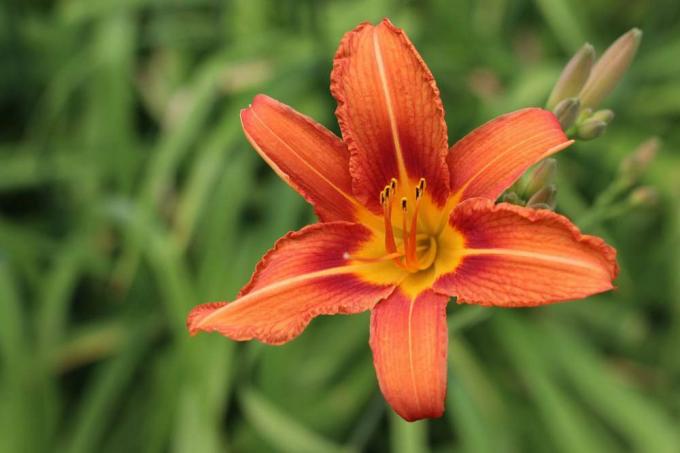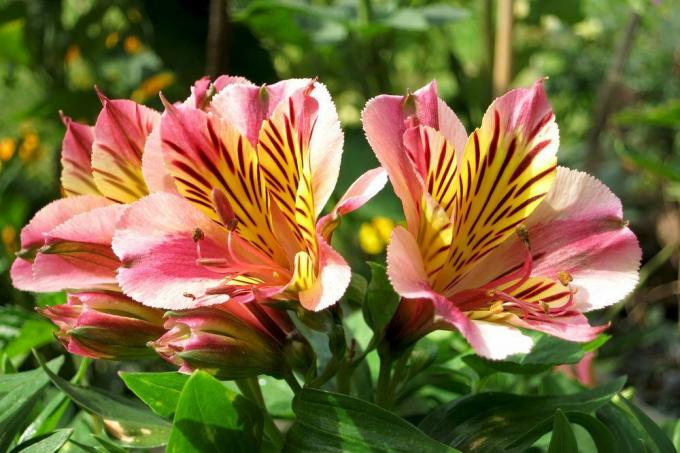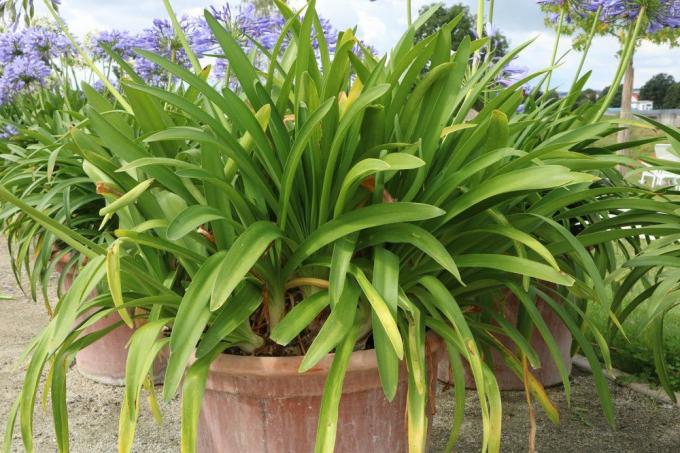
table of contents
- Lilies and lily plants
- Winter hardy Lilium hybrids
- Not hardy lilies
- Hibernate lilies properly in the garden
- Hibernate lilies properly in the pot
- Frost-free wintering of the lily bulbs
When the leaves of the trees gradually turn brightly colored, autumn is approaching with great strides. Now it's time to winterize the garden. Many typical garden plants survive the cold season outdoors without any problems. But what about the different types of lilies? Can they survive frost and moisture or do they have to be dug up and wintered frost-free? How hardy are the common Lilium species actually?
Lilies and lily plants
Risk of confusion: not every lily is actually a lily plant
Not everywhere where a “lily” is hidden in the name is it actually a lily plant. The day lily (Hemerocallis), the belladonna lily (Amaryllis belladonna) and the scallop lily (Sprekelia formosissima) do not belong to the lily family. You can recognize real lilies by their botanical name "Lilium". Nevertheless, at this point we will also inform you about the actual winter hardiness of the "wrong" lilies:
- Daylilies: hardy to - 15 ° C or - 20 ° C, depending on the variety
- Belladonna lily / real amaryllis: sensitive to frost, winter frost-free at 10 to 15 ° C
- Jacob's lily: sensitive to frost, frost-free, dry and dark over winter at around 15 ° C
- Toad Lily / Tiger Star: Tricyrtis hirta, briefly winter hardy down to - 20 ° C, thick layer of mulch protects against frostbite

Winter hardy Lilium hybrids
Just a few decades ago, real lilies were considered extremely capricious. Many species, although mostly native to the northern hemisphere, were not sufficiently hardy for most regions in Germany. They had to be dug up in autumn and wintered frost-free.
Today, however, robust, easy-to-care-for and hardy hybrids are available in garden centers and specialist shops. These are crosses of different types of lilies, which were then selected not only for their beauty, but also for other desirable properties such as winter hardiness. Therefore, with a few exceptions, you can safely leave modern types of lily in the garden and bring them through the winter with just a few protective measures.
These lilies can be left outside in winter
The following types of lily are particularly well equipped for winter:
- Asiatic lily: most common group of hybrid varieties, usually frost-resistant, but need light winter protection
- Oriental lily: hybrid breeds mainly from Japan, usually frost-resistant, but need light winter protection
- Turkish lily: native species, hardy, no special winter protection necessary
- Chinese mountain lily: belongs to the Chinese Turkish lily, frost and winter resistant, light winter protection makes sense
- Trumpet lily: Lilium longiflorum hybrids, frost and winter resistant with light protection
- Royal lily / white lily: Lilium regale, one of the most famous trumpet lilies, reliably frost-hardy, light protection necessary
- Nepal lily: Hybrid breeding from Lilium nepalense x oriental, hardy, needs light winter protection
- Canada lily / Canadian water lily / Canadian meadow lily: Lilium canadense, native and widespread species in many provinces of Canada, well hardy, frost hardy
- Tree lilies: well hardy, but light winter protection (mulch layer) makes sense
- Fire lily: Lilium bulbiferum, native species, occurs wild on meadows primarily in the foothills of the Alps and in the Harz Mountains, no frost protection necessary
- Tiger lily: Lilium lancifolium, native to East Asia, reliably frost hardy, but does not tolerate winter wetness
- Panther lily: Lilium pardalinum, native to western North America, winter protection (mulch layer, e.g. B. Pine bark) makes sense
- Magnificent lily: Lilium spec. rubrum, sufficient winter hardiness

Not hardy lilies
These lilies are delicate
In contrast to the lily species and hybrids listed above, both the exotic Inca lily and the Madonna lily is not sufficiently hardy and therefore needs a special one during the cold season Care.
The Inca lily (Alstroemeria) native to the subtropics does not survive a winter with prolonged frost, even if the plant gains winter hardiness with increasing age. In regions with mild winter conditions (for example in wine-growing areas) the onions can remain in the ground, but must be covered with a thick layer of mulch. In regions with probable periods of frost, however, an autumn excavation and frost-free wintering are recommended.
The Madonna Lily (Lilium candidum) is one of the oldest species of lily. It comes from the Mediterranean region, needs a full sun and sheltered location - as well as adequate winter protection. Well covered with brushwood and a thick layer of mulch, the bulbs can stay in the ground during the cold season.

Hibernate lilies properly in the garden
Regardless of whether they are oriental, Asian or other hardy lily species: Most of them require light protection during the winter months. This ideally consists of one Cover with sticks, for example fir or spruce branches, which are primarily intended to protect not from frost, but from moisture. In many cases, the problem is not temperatures falling below zero, but damp winters. Most lilies do not tolerate moisture at all and rot. Moisture in combination with persistent frost can also be fatal for the flowers: The onions soaked with water can burst open and thus be destroyed. The ideal winter protection for Lilium is therefore first and foremost protection against moisture and is done in this way:
- Cut the yellow and brown leaves down to the ground
- withered flowers too
- Covering the root area with compost / humus
- further cover with sticks
Hibernate lilies properly in the pot
If, on the other hand, the flowers are grown in pots, more comprehensive protection is recommended. Since there is naturally very little soil in planters, it cannot provide adequate frost protection. At best, you help with one Fleece coat after you wrap around the pot. The vessel is in turn on a insulating pad made of wood or styrofoam and placed against a wall. Finally, cut down the above-ground parts of the plant and cover the root area with a thick layer of sticks.

Frost-free wintering of the lily bulbs
Lily species that are not sufficiently winter-proof, on the other hand, should be dug up in autumn and overwintered frost-free. To do this, proceed as follows:
- Cutting down wilted inflorescences or Seed pods
- Cut down yellow or brown leaves
- Digging up the onions, cleaning off any clinging earth
- Air dry onions for two days
- Fill a wooden box or basket with sawdust
- Store the onions airily in it
- Winter onions dark, dry and frost-free at 10 to 15 ° C
- Possible winter locations: cellar, garage, garden shed, attic
It is absolutely necessary to first remove the yellowed or Cut off withered leaves, as the nutrients contained in the green foliage are absorbed by the onion and required for renewed sprouting in spring.
